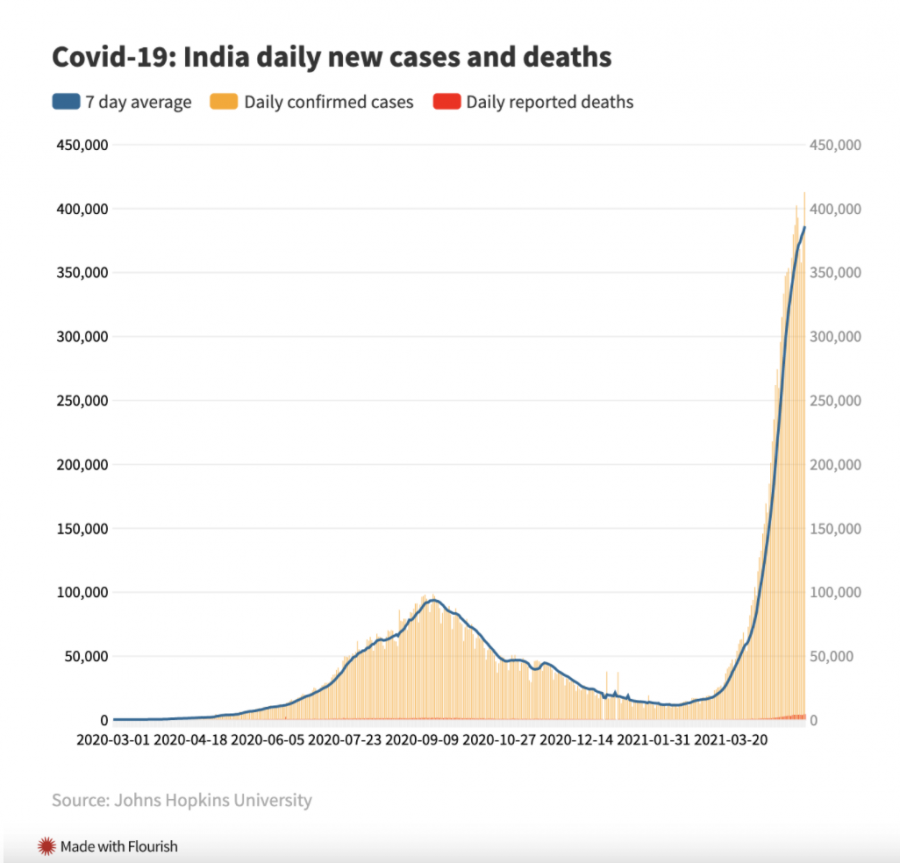India’s Covid-19 Crisis And Why It’s More Serious Than You Think
May 26, 2021
Recently, the U.S. has seen a massive improvement with COVID-19. Vaccines are being distributed, schools are opening back up, and daily life is returning to some semblance of normal. Most Americans seem to be quickly forgetting what it was like to be mid-COVID crisis, eager to move forward with their lives. However, we cannot forget the countries and people left behind. While the U.S. has been making steady progress, the same can not be said for other countries, most notably India.
As the second largest country in the world, with a staggering population of 1.366 billion, India has been a concern throughout the pandemic. However, India was spared from being overwhelmed with the virus until now. The difference is that more contagious variants have taken hold and vaccine distribution can’t keep up. A second wave of COVID-19 has swept through the country, and according to Reuters, “a record 412,262 new cases were reported over the past 24 hours, taking total infections past 21 million and the overall death toll to 230,168, Health Ministry data showed.” So far, the capital New Delhi and several other cities are struggling due to the limited public healthcare. This is especially concerning to rural areas that are home to nearly 70% of the population. Indian Foreign Minister Subrahmanyam Jaishankar admits the healthcare system “stands exposed” after 75 years of underfunding by successive governments since independence from Britain. Further accentuating his point on Wednesday, he stated, “It’s very easy to say today that we should have put in more money. Now that I am in government…, I can say it is not as easy as it sounds.”
India is the world’s biggest vaccine producer, yet it is struggling to create and distribute enough vaccines for the people. CNBC claims that India’s, “two current vaccine producers will take two months or more to boost monthly output to more than 110 million doses from 70 million-80 million.” Meaning that until then, the amount of cases and deaths will only increase. Additionally, India has run out of oxygen and other basic medical necessities needed to care for its citizens. In the office of a Hindu crematorium in Delhi, the floor and shelves were overflowing with the ashes of people who have died from COVID-19. Narendera Modi, the Prime Minister of India, had been widely criticized and held responsible for these deaths due to his lack of action to suppress the second wave sooner, especially after considering the religious festivals and political rallies which drew tens of thousands of people in recent weeks.
As it stands, India’s outbreak is already affecting other countries. Its neighbors Nepal and Sri Lanka have reported increases in infections, while other regional economies including Hong Kong and Singapore have seen imported Covid cases from India (CNBC). A large side effect of this is that prolonged large outbreaks can lead to new variants of COVID-19; variants that could evade immune responses triggered by vaccines and previous infections.
Recently, U.S. President Joe Biden announced that he would support waiving intellectual property rights for COVID-19 vaccines. This would make the vaccines more widely available. However, it could take months for the World Trade Organization to follow through with the deal.
Another large issue surrounding this is India’s status as the world’s sixth largest economy and a major contributor to global growth. This will not only affect the global economy, but will also have a large impact on the countries India is giving the vaccines to. Many health officials worry about the extreme amount of vaccines the country must produce to immunize its own population of 1.3 billion people, not to mention the other countries dependent on India’s vaccine production. So far, India is producing roughly 2 million vaccine doses each day, according to Dr. Soumya Swaminathan, chief scientist for the World Health Organization. But the country needs to vaccinate between 6 and 7 million people per day, she said, and that rate demands that India “needs to be increasing manufacturing capacity several fold.”
Overall, the crisis is not simply a problem for India to solve. We are all responsible for our own actions, and measures can be taken for you to aid India. First, and most importantly, spread the discussion. Communication is the best way to create change. Next, there are different organizations you and your family can use to donate according to PBS. To help organizations that fund and provide medical supplies like oxygen and PPE, donate to Direct Relief, Oxygen for India, Project HOPE, Association for India’s Development, The American India Foundation, and The Indian Red Cross Society. To help organizations that serve India’s marginalized communities, try donating to Indian Muslim Relief & Charities, Khalsa Aid, The Transgender Welfare Equity and Empowerment Trust, Care India, Make A Difference. You can find more information on each of these online, or on the PBS website linked above. Please be aware that every contribution matters, and everyone as a society must unite to defeat the pandemic. This second-wave of COVID-19 in India is not simply a one-country problem, it is a worldwide one.
Works Cited
“COVID-19 in India – COVID-19 Very High – Level 4: COVID-19 Very High – Travel Health Notices.” Centers for Disease Control and Prevention, Centers for Disease Control and Prevention, wwwnc.cdc.gov/travel/notices/covid-4/coronavirus-india.
Santhanam, Laura. “COVID-19 Is out of Control in India, Where Most Vaccines Are Made. How Did That Happen?” PBS, Public Broadcasting Service, 27 Apr. 2021, www.pbs.org/newshour/health/covid-19-is-out-of-control-in-india-where-most-vaccines-are-made-how-did-that-happen.
Tanvi Mehta, Shilpa Jamkhandikar. “COVID-19 Spreads to Rural India, Villages Ill-Equipped to Fight It.” Reuters, Thomson Reuters, 6 May 2021, www.reuters.com/world/india/india-sees-record-daily-rises-covid-19-infections-deaths-2021-05-06/.
YenNee_Lee. “India’s Worsening Covid Crisis Could Spiral into a Problem for the World.” CNBC, CNBC, 6 May 2021, www.cnbc.com/2021/05/06/indias-worsening-covid-crisis-could-spiral-into-a-problem-for-the-world.html.





